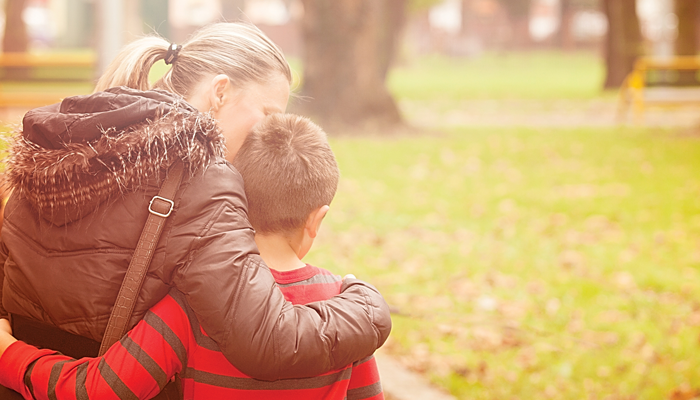Your five-year-old plays in the backyard, contentedly immersed in a world of sunshine, sandboxes, and swings. How will you bring up the fact that her birth parents left her alone in a public place?
You’ve been evasive about the details of your eight-year-old son’s life before adoption. Lately, he’s been asking questions. Is now the time to tell him that his birth mother was an alcoholic?
You are wondering whether your teen’s recent bouts of anger result from the news that his biological siblings live with his birth parents. Was telling him the right thing to do?
Adoption is a joy that sometimes comes with sadness, especially if there’s a difficult side to your child’s story. Your natural desire is to shield your child, to maintain his innocence as long as possible. You want to focus on the happiness he’s brought to your family. When talking about adoption to your adopted child, is it ever O.K. to veil, or just plain bury, sad truths in his past?
You Must Tell
Absolutely not, say the experts in an almost unanimous chorus. “During my 30 years working in the field, I’ve never seen information an adult adoptee shouldn’t know,” says Ronny Diamond, an adoption therapist and director of the adoption consultation team at Spence-Chapin, in New York City.
“Ask yourself, ‘Why don’t we talk about this?'” advises Jayne E. Schooler, co-author of Telling the Truth to Your Adopted or Foster Child. “Is it because we think he’s not ready to know, or because we’re not ready to tell him?”
Naturally, you’ll share information in ways that are appropriate to your child’s age and abilities. “Children are entitled to information, but that doesn’t mean a parent needs to say everything at once,” says Diamond. “Parents have the responsibility to make decisions in the child’s best interest, including what to share and when and how to share it.”
Preschoolers can’t understand abstract concepts or culture-wide prejudices. They don’t know how babies are made, so they can’t make sense of rape or prostitution. Experts disagree as to when older children can be told painful personal information. Some maintain that a child should know everything about his past by age 12, others advise withholding particularly tough details until the late teen years.
No matter how you choose to approach this difficult task, is is critical that you tell your child the story of his past. “It’s not a parent’s job to keep information from a child,” says Diamond. “It’s the parents’ job to help the child make sense of that information.”
You do that by explaining things in a positive, understandable way, by answering any questions your child asks, and by providing the context to help her begin to make sense of her birth family’s actions.
How often should you talk about adoption? Adoption scholar David Brodzinsky, Ph.D., of Rutgers University, has a rule of thumb. If you can’t remember the last time you talked about adoption, it’s time for a conversation.
Others, mindful of reports by adult adoptees that adoption was on their mind as a child much more than it was discussed at home, suggest that parents toss out an adoption comment on a regular basis. This way, your children will have frequent openings to ask any questions or raise concerns.
Gauge your child’s interest and curiosity before diving into a difficult discussion. Holly van Gulden, author of Real Parents, Real Children, outlines what she calls the “pebbles” technique: Toss out a casual comment, such as, “I wonder whether your birth parents are as talented in math as you are,” and see if it leads to a conversation.
If your child doesn’t respond, move on. Drop another “pebble” a few weeks later. Maintaining open lines of communication about adoption will make it much easier to broach the difficult aspects of the story when the time is right.
Straight talk about tough personal details will undoubtedly be emotional, even painful. But plenty of counsel is available to help you manage the conversations.
The Preschool Years: Telling the Story
There are two keys to sharing adoption information with preschoolers. First, tell the child’s story as a story, not as a dry recital of facts. If “Once upon a time” catches your child’s interest, lead off with it and go from there. Just make sure your child knows that, unlike a fairy tale, this story is true.
Second, tell no lies. As a fiction writer, I’ve been tempted to embellish my daughter’s adoption story. But I know that anything I say may be taken and remembered as fact, so I leave her story unadorned. “Adoptive parents who ‘create’ a story have to remember all of its details — or risk confusing their child,” warns Schooler.
Limit the negative details at this age. “You wouldn’t explain rape and incest to a six-year-old,” says adoption therapist Brenda McCreight. “So why talk about such things in relation to the child’s own life?”
Older preschoolers can handle more than you may think. Marijke Breuning had told her young daughters that their “Ethiopia mommies” were too ill to care for them. Recently she added the fact that they had died. One of her daughters became upset at the thought that her mother had misled her earlier. “I explained that I had not lied, I had told her only the first part of the story. Her Ethiopia mommy had been very sick, and had eventually died from the illness,” explains Breuning. “Knowing that the first story and the new information fit together made a big difference.”
Those Magical Middle Years
Somewhere around age seven to nine, children make a cognitive leap. They’re able to understand abstract concepts and are likely to have more questions about the adoption story you’ve told them. While kids of this age might seem young and tender to parents, in fact, they’re highly resilient. This is often the ideal age for sharing or revisiting thorny realities.
Older elementary-age kids haven’t yet entered the tempestuous stage of adolescence. They’re talking to you — and listening to what you have to say. They have time to integrate new information about their past before redefining their identities as teenagers.
It’s important to keep in mind that each child processes information at his own pace. When a mother in California contacted her son’s birth family in Russia in search of medical information, she learned some new, difficult details about the birth family. Although the parents decided to wait to tell their son much of the new information, they did tell him that he has a biological sibling. “It took my son several months to look at the photograph of his brother that we received,” the mom recounts. Nonetheless, in an “encouraging development,” her son recently felt comfortable enough to mention his brother to a friend.
This is also the age that a child can understand the social context of his birth parents adoption decision. Learning about the social conditions that might have lead to infant abandonment, such as extreme poverty, drug or alcohol addiction, or prejudice against unwed mothers, can be very important in helping a child make sense of his past.
Don’t forget to balance facts with feelings and speculation. If you are someone who is most comfortable with hard data, remind yourself to ask open-ended, emotional questions. In the case of abandonment, you might say: “I wish we knew more about your birth parents! Does it ever make you mad that we don’t?” If a child’s biological siblings are being raised by his birth parents, you might say: “I wonder how your life would have been different if your birth family had been able to raise you instead of your brother?”
Let your child decide what, if anything, he wants to do with any new information. “His brother is willing to be contacted,” says the California mom. “It’s hard to say right now if my son will want to write to him, but,” she notes wisely, “It’s entirely up to him.”
What Happens in Adolescence
Adolescence is the time to continue filling in the details. Be prepared for some turbulence as your child struggles to figure out who he is. If the adoption conversation has been open thus far, it’s likely to remain so during adolescence. “If the parents have been honest, then the door is open to expand on what the teen has been told as a younger child,” says McCreight.
In most situations, with most children, adoption experts say that difficult adoption information is best shared by the child’s parents. After all, they are the people who love him and are trusted by him. Parents may benefit from consulting a therapist for advice on what to say, how to say it, and to otherwise prepare for challenging conversations, says Diamond. “But having a therapist talk separately to a child should be the last option.”
Developing Compassion
Talking about adoption to your adopted child isn’t always going to be easy, but thoughtful discussions over the course of childhood can help your child develop compassion for families in difficult circumstances — families like their birth families — without the resources to cope. Our goal is not to excuse neglect, abuse, or other hurtful behavior. In fact, says Schooler, it’s wise to affirm a child’s negative feelings. If a child reacts by saying, “I hate my birth parents,” don’t rush into an explanation of why they have problems. A gentle “I understand” can work wonders.
One adoptive mother in the Milwaukee area has always been open with her twin sons about the fact that their parents’ alcohol abuse led to their leaving the boys in a burning apartment. She tells her boys that their birth parents must have been very loving when they weren’t drinking, because the boys were so affectionate when they joined their adoptive family. “I guess I’m trying to help them see alcohol as the culprit, not their birth parents,” says this mom.
Another mother who has worked extensively, both at home and in therapy, to help her daughter understand difficult medical and personal information about her birth family, reports that good has come out of the pain. “My daughter has confronted conflicting emotions, the grays in life, much earlier than other kids,” she writes. “Helping her understand that sorrow and joy can coexist over the same experience is, perhaps, a loss of innocence — but also a gain in maturity.”
Ultimately, says Diamond, “We want our children to be able to say, ‘My birth parents did the best they could, even if it wasn’t enough.'”


